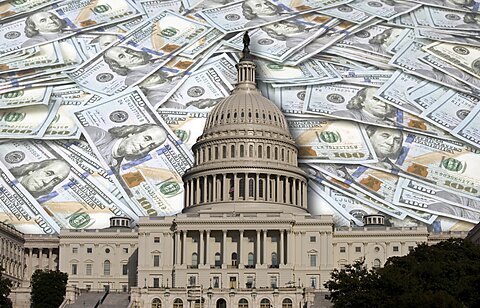
It’s Not Just Republicans, Democrats Want Trillion-Dollar Tax Cuts Too
Since Republicans passed their 2017 tax cut along partisan lines, Democrats have derided the reforms as costly tax cuts for the rich that should never have been passed. As those tax cuts edge closer to expiring at the end of 2025, there are almost no voices calling on Congress to let taxes automatically increase on 95 percent of Americans.
Perhaps surprisingly, there is general bipartisan agreement on tax cuts. Republicans and Democrats often propose different types of tax cuts—with different implications for economic growth—but most want to reduce federal revenues collected from most Americans all the same. President Biden’s budget supports extending about $2 trillion of the Trump‐era tax cuts, in addition to expanding tax‐credit subsidies included in his multi‐trillion‐dollar Build Back Better spending plan.
As Congress begins to grapple with the coming 2025 fiscal deadlines, it’s worth understanding that many Democrats support about three‐quarters of the Republican tax cuts. And many more suggest expanding the tax cuts further. Politicians’ desire to keep taxes low is admirable, but keeping taxes low for the long haul will also require keeping spending in check.
Tax Cuts for Democrats
It is common knowledge that most Republicans support tax cuts. It is often left out of the conversation that Democratic politicians also support trillions of dollars in tax cuts without proposing realistic offsets.
Democrats have their own tax‐cutting agenda. For example, in 2022 they passed an almost trillion‐dollar corporate tax cut through energy and other credits as part of the Inflation Reduction Act (which will reduce revenue even with the offsetting tax increases).
There is broad congressional support among Democrats for an increase to the child tax credit and earned income tax credit in the ballpark of $1.7 trillion over ten years. I recently wrote about a tax cut deal proposed by Democrats to pair a smaller child credit expansion with some expiring business tax cuts. If made permanent, it could be an $800 billion tax cut. Many Democrats also support eliminating the cap on the state and local tax deduction, effectively cutting taxes for the wealthiest taxpayers by as much as $850 billion over 10 years (from a current policy baseline).
The biggest tax cuts (more accurately, forestalling tax increases) supported by Democrats are described in President Biden’s 2024 Budget, which calls for making the Trump‐era tax cuts permanent for people making less than $400,000 a year “in a fiscally responsible manner.”
Extending the 2017 tax cuts permanently for people making less than $400,000 would cost somewhere in the ballpark of $1.7 trillion and $2.5 trillion, depending on the details, or between 50 percent and 75 percent of the $3.3 trillion ten‐year total cost.
Democrats also have lots of proposals to increase taxes on businesses and high‐income Americans, but none can pay for the trillions of dollars of tax cuts most members in Congress support. Confiscating all the annual income earned by Americans above $400,000 a year would not cover the currently projected deficits, let alone any additional spending or lower taxes.
The president’s budget does not bother proposing any specific new taxes or spending cuts to offset the cost of extending the 2017 tax cuts. It simply assumes Congress will come up with trillions in new revenue. It is unlikely a majority of Democrats would vote for trillions of dollars in additional tax increases beyond the nearly $5 trillion in optimistically assumed higher revenues already proposed in the president’s budget.
The 2025 Fiscal Cliff
Simply because there is bipartisan consensus to keep taxes low on more than 95 percent of Americans does not mean such tax cuts are possible without other reforms. If policymakers want to permanently extend the 2017 tax cuts, they will need to pursue spending reforms and eliminate politically popular tax subsidies.
Current budget projections assume that after 2025, taxes will increase by more than $300 billion a year on Americans at every income level. Starting in 2026, tax rates increase at every income level, the child tax credit is halved, the standard deduction decreases, and effective tax rates on new investments in American workers continue to climb as business expensing phases out.
Even with these automatic—and economically damaging—tax increases, budget deficits are projected to rise to about $2.8 trillion a year by 2033, a cumulative $20 trillion deficit over the decade.
Both Republicans and Democrats want to keep taxes from rising on the vast majority of Americans, and most legislators also want to protect higher‐income Americans from punishingly higher taxes. These simple facts are irreconcilable with current spending levels and the rhetoric from both parties about what types of spending are off the table. Fiscal fantasies run deep in both parties.
Policymakers’ instincts are correct; it is best to keep taxes low on Americans at every income level. However, keeping taxes low will require spending cuts. Otherwise, taxes will necessarily have to increase in the coming years.



